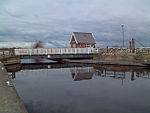Sandtoft, Lincolnshire
Borough of North LincolnshireHamlets in LincolnshireLincolnshire geography stubsUse British English from January 2014

Sandtoft is a hamlet in the civil parish of Belton, North Lincolnshire (Where the population is included), England. Sandtoft is in Hatfield Chase on the Isle of Axholme, 3 miles (5 km) north-west from Epworth. Sandtoft has a public house, The Reindeer Inn.RAF Sandtoft was an RAF Bomber Command airfield. It opened in April 1944, closed in November 1945 and was sold for civilian uses in 1955. Today part of the site is Sandtoft Airfield and The Trolleybus Museum at Sandtoft, Europe's largest trolleybus museum, is on another part. In 2021 it was incorrectly signposted as part of Yorkshire.Sandtoft and nearby Epworth, Lincolnshire were centres of unrest during the 17th draining of The Fens.
Excerpt from the Wikipedia article Sandtoft, Lincolnshire (License: CC BY-SA 3.0, Authors, Images).Sandtoft, Lincolnshire
Geographical coordinates (GPS) Address Nearby Places Show on map
Geographical coordinates (GPS)
| Latitude | Longitude |
|---|---|
| N 53.56401 ° | E -0.874245 ° |
Address
DN8 5SX
England, United Kingdom
Open on Google Maps








